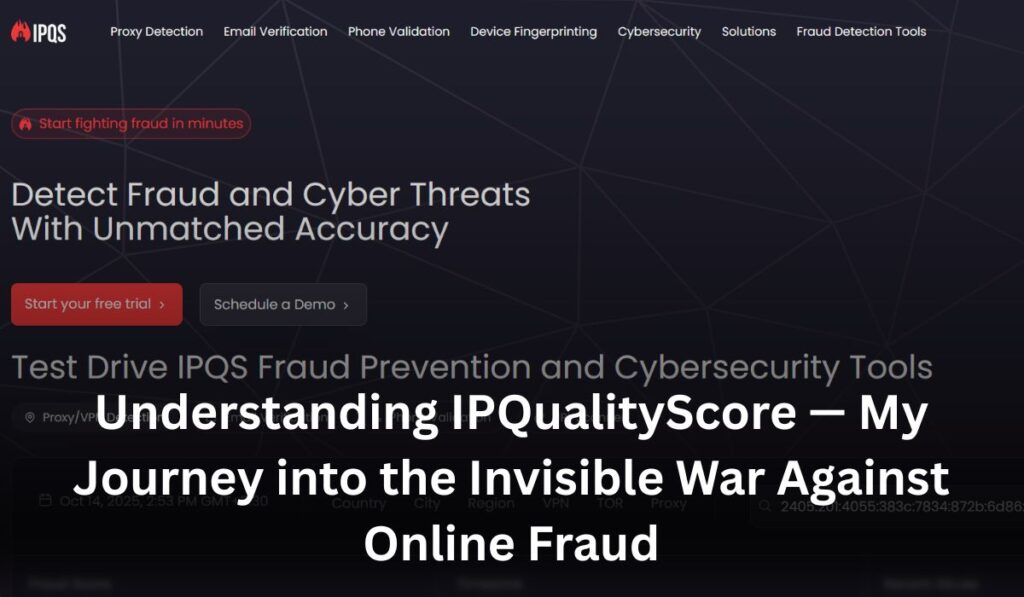
It started on a regular workday. The kind where your coffee tastes a little too bitter and your to-do list feels endless. I was reviewing web traffic analytics for a small e-commerce client, wondering why their ad spend was skyrocketing but conversions weren’t matching up.
Everything looked fine on paper — same campaigns, same audience, same platforms. But something didn’t add up.
Late that night, after everyone had logged off, I stared at the dashboard again. Thousands of “visits.” Hundreds of “clicks.” But barely a handful of real customers.
It felt like chasing ghosts.
And that’s when I came across a tool that changed how I looked at internet traffic forever — IPQualityScore, or simply IPQS.
The Night of the Discovery
The office was dim, lit only by the faint glow of my monitor. My playlist was looping the same lofi beat it had been for hours. I typed “detect fake traffic tool” into Google.
The first few results were the usual — analytics tools, ad filters, cookie blockers. Then I found a page titled:
“IPQualityScore: Fraud Prevention & Threat Intelligence.”
It sounded almost cinematic.
I clicked.
What unfolded wasn’t just another tracking tool — it was like peering into the matrix of how the internet actually works.
IPQualityScore, as I learned, doesn’t just look at where someone comes from. It judges their intent.
Every IP address.
Every browser.
Every click.
Scored. Ranked. Evaluated.
Not by humans, but by algorithms that can tell whether a user is real or fake — bot or human, customer or scammer.
What I Learned About IPQualityScore
IPQualityScore (or IPQS for short) is a fraud prevention and threat intelligence platform. It’s designed to evaluate risk based on a mix of digital fingerprints — your IP address, device details, behavioral patterns, and even how your browser behaves when rendering a page.
In other words, it doesn’t just see what you do. It tries to understand who you really are behind the screen.
It processes billions of events every month, analyzing data from across the internet. Each IP is scored based on:
- Reputation: Has this IP been linked to abuse or malicious behavior?
- Location & ASN: Where is it coming from? A data center, VPN, or home connection?
- Behavior: Is the mouse movement too perfect? Is the typing speed too fast or too slow?
- Device fingerprint: Does this device appear frequently from different locations or accounts?
The result? A real-time fraud score that tells companies whether to trust or block a user.
And for businesses fighting fake clicks, bots, or account abuse — this is gold.
The Hidden Side of the Internet
Before IPQS, I used to imagine the internet as a network of users — people like you and me browsing, shopping, scrolling.
But after diving into IPQS reports, I saw another world beneath the surface.
A world where fake users outnumber real ones in certain industries.
Where bots mimic human behavior so well that even advanced systems get fooled.
Where stolen identities and spoofed fingerprints circulate like currency.
It was both fascinating and terrifying.
The truth is, most of us have no idea how much of the “traffic” online isn’t human at all. Ad clicks, sign-ups, even product reviews — many are automated or fraudulent.
And that’s what IPQualityScore was built to detect.
My First Experiment
I decided to test it.
Using the IPQS API, I ran a batch of IPs from my client’s analytics logs. Within seconds, it flagged over 40% as high risk.
- Some were VPNs or proxies.
- Others were Tor users masking their location.
- A few came from IPs linked to known botnets.
It was like shining a flashlight into a dark room and seeing movement you didn’t know was there.
I remember sitting back in my chair, a mix of awe and unease settling in.
That night, I realized the biggest enemy of online business wasn’t competition — it was invisibility. The invisible fraud, invisible bots, invisible manipulation.
And tools like IPQualityScore were the first step in fighting back.
How IPQS Works (Without the Tech Jargon)
Let’s simplify this.
Every time you load a webpage, your browser reveals a lot about you — your IP address, device type, timezone, browser version, and even small rendering quirks unique to your system.
IPQS takes all that information and runs it through a machine learning model trained on billions of real events.
It looks for patterns that don’t fit normal human behavior — like:
- Mouse movements that are too straight or repetitive.
- Page visits that happen faster than any person could click.
- IPs known to host multiple fake accounts.
- Devices appearing from different regions within seconds.
Then it gives each user a fraud score — a number between 0 and 100.
The higher the score, the riskier the user.
If you’re a business, you can decide what to do next: block the user, challenge them, or log them for review.
Simple, right? But incredibly powerful.
Where It’s Used
Over time, I learned that IPQS isn’t just for big corporations. It’s used across industries:
- Ad tech companies use it to detect click farms and fake ad impressions.
- E-commerce platforms use it to block stolen card purchases and bonus abuse.
- Banks and fintech rely on it to prevent account takeovers and credential stuffing.
- Gaming companies use it to stop multiple fake account registrations for promotions.
It’s everywhere — quietly watching, analyzing, and protecting.
And yet, most users have no idea it exists.
The Cat-and-Mouse Game
Here’s the thing: for every security measure, there’s always someone trying to beat it.
After learning about IPQS, I dove deeper into how fraudsters try to evade it.
They use anti-detection browsers, clean residential IPs, fingerprint spoofing, and even AI-generated behavior that mimics humans down to the scroll speed.
It’s a digital arms race — defenders build smarter systems, and attackers build smarter tools to bypass them.
It reminded me of a chess game that never ends.
And that’s what makes cybersecurity both thrilling and exhausting.
Because the moment you think you’re safe, someone’s already figuring out how to slip through the cracks.
Lessons from the Digital Battlefield
After months of working with IPQS and analyzing results across different clients, I started noticing patterns — not just in the data, but in my mindset.
Here’s what I learned:
- Numbers can lie — patterns don’t.
Traffic numbers can look good, but only behavior reveals truth. Real users act differently than bots, no matter how well disguised. - The enemy isn’t the hacker — it’s complacency.
Fraud thrives where systems assume “it won’t happen to us.” Awareness is the first defense. - Technology alone isn’t enough.
IPQS is powerful, but pairing it with human intuition — understanding your audience, verifying patterns — makes it truly effective. - Transparency builds trust.
When users know your systems protect them, they feel safer. Security isn’t just protection — it’s reputation. - Every signal tells a story.
A high-risk score isn’t just data; it’s a narrative — of where a user came from, what they’re hiding, and why they might be acting suspiciously.
Can You Detect IPQS?
Interestingly, I found out that just as IPQS detects fraud, some people try to detect IPQS itself — to know if a site is using it.
You can sometimes tell if a website uses IPQS by:
- Watching for API calls to
ipqualityscore.comduring form submissions. - Noticing slight delays in signup or login processes (that’s real-time scoring at work).
- Spotting JavaScript SDKs or hidden fingerprinting scripts in the page source.
- Detecting behavioral challenges or invisible “honeypots” in forms.
It’s subtle, but if you look closely, you can see the digital footprints of IPQS quietly doing its job.
How Businesses Can Strengthen Defense
Over time, I also learned that just integrating IPQS isn’t enough.
Fraudsters are evolving. To truly protect your system, you need layers:
- Track IP history — watch for users switching IPs too frequently.
- Detect fingerprint spoofing — monitor for manipulated canvas or audio fingerprints.
- Rate-limit risky actions — slow down logins or purchases from flagged users.
- Add behavioral biometrics — track typing speed, mouse flow, and scroll rhythm.
- Use honeypots — invisible traps for bots and spoofed devices.
Security is no longer about building walls. It’s about building smart ecosystems that learn, adapt, and evolve faster than attackers.
The Human Side of It All
After months immersed in IP reputation data, fraud patterns, and risk scores, I started to notice something deeper — the human cost of fraud.
Behind every stolen credit card was a real person who lost something.
Behind every fake account was a company fighting to stay alive.
Behind every fraud detection system was a team of engineers burning midnight oil to make the web a little safer.
We often think of cybersecurity as a technical field, but it’s actually deeply human.
It’s about trust.
It’s about safety.
It’s about preserving the fragile digital relationships that power our modern lives.
My Takeaway
Working with IPQualityScore taught me that the internet is both brilliant and broken. It connects us like never before — but it also opens the door to new kinds of deception.
We live in a time where authenticity has become rare currency.
And tools like IPQS remind us that behind every click, there’s a story — sometimes honest, sometimes malicious.
But awareness changes everything.
When you know what’s out there — when you can see beyond the surface — you begin to make smarter choices, build safer systems, and trust a little more wisely.
Final Reflection – Growth and Resilience in a Digital World
As I close my laptop and glance at the reflection of the night sky on my screen, I can’t help but think — the battle between trust and deception is as old as humanity itself.
The only difference now is that it’s digital.
IPQualityScore isn’t just a tool; it’s a mirror — showing us the complexity of our connected world.
It reminds us that growth comes from awareness, not fear. That resilience isn’t about being invisible, but about being prepared.
The internet will keep evolving — so will fraud.
But so will we.
And maybe that’s the most human thing of all — the ability to learn, adapt, and keep building trust in a world full of noise.
Because in the end, resilience isn’t just surviving the digital storm.
It’s learning how to see clearly through it.






